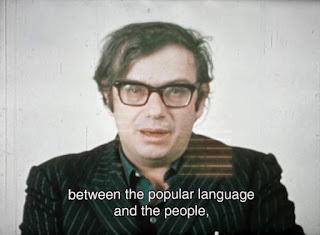Beauty Out of Brutalism
About Nausicaa [1970, 1 hour 38 minutes and which only survives as a workprint — its other elements destroyed — included in a (naturally) busted scan within Criterion's The Complete Films of Agnès Varda], the question might be posed: Who or what represents the title character; who or what, the figure of Odysseus? Varda fits as the succoring princess; the questing hero too. The hero themself bifold: Varda the searcher, also the nation-state Greece in the aftermath of the putsch whereby US-supported right-wing military forces staged an overtake of Athens at the hands of a band of nationalist, albeit anti-royalist, colonels.
Demotic (popular) language, the language of ancient tragedy, the maiming of classical statuary, "computer controlled arrests." In Greece 1970 the past is superimposed over the present, like Philip K. Dick's "Empire" in his later, American VALIS. The Greeks describe the wonders of their country in terms of sky and air. Key ingredients in fabricating a popular cinema — topping layers too — sky and air remaining common to fiction and documentary, signifiers of the outside world that ineluctably interrupt and buoy Varda's film even as it moves back and forth between distinctions that perhaps require no distinguishing, e.g., heavens and earth, revolution and peace, Agnès and Rosalie. •
===
Other writing on Agnès Varda at Cinemasparagus:
La Pointe-Courte [1955]
Ô saisons ô châteaux [O Seasons, O Châteaux, 1957]
L'Opéra-Mouffe, carnet de notes filmées rue Mouffetard par une femme enceinte en 1958 [The Opéra-Mouffe: Diary Filmed on the rue Mouffetard in Paris by a Pregnant Woman in 1958, 1958]
Du côté de la Côte [Around the Côte, 1958]
Les fiancés du pont Mac Donald, ou (Méfiez-vous des lunettes noires) [The Fiancés of the Pont Mac Donald, or: (Beware of Dark Glasses), 1961]
Cléo de 5 à 7 [Cléo from 5 to 7, 1962]
Elsa la Rose [Elsa the Rose, 1966]
Les créatures [The Creatures, 1966]
Lions Love... and Lies / Lions Love [1969]
Plaisir d'amour en Iran [Giddiness of Love in Iran] [1976]
L'une chante l'autre pas [The One Sings the Other Doesn't] [1977]
===









No comments:
Post a Comment
Note: Only a member of this blog may post a comment.